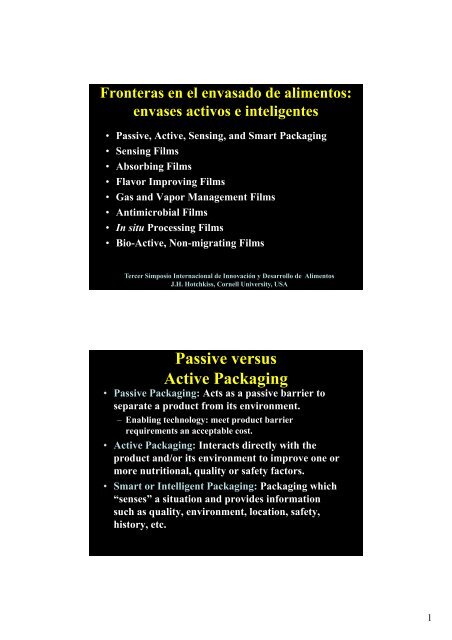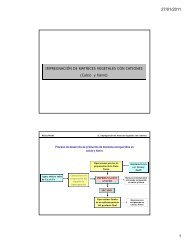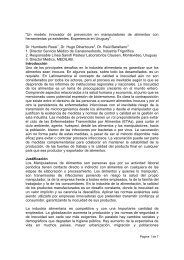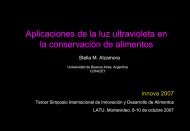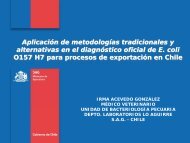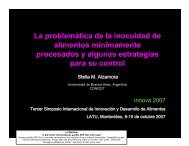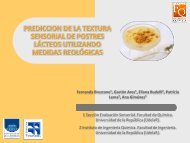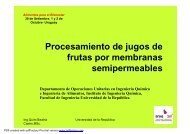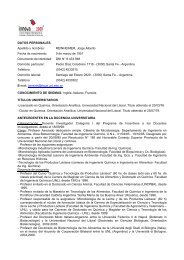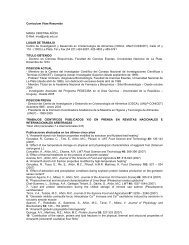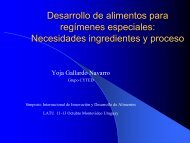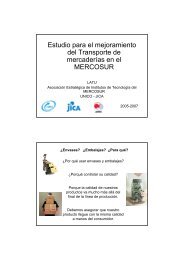Passive versus Active Packaging
Passive versus Active Packaging
Passive versus Active Packaging
Create successful ePaper yourself
Turn your PDF publications into a flip-book with our unique Google optimized e-Paper software.
Fronteras en el envasado de alimentos:<br />
envases activos e inteligentes<br />
• <strong>Passive</strong>, <strong>Active</strong>, Sensing, and Smart <strong>Packaging</strong><br />
• Sensing Films<br />
• Absorbing Films<br />
• Flavor Improving Films<br />
• Gas and Vapor Management Films<br />
• Antimicrobial Films<br />
• In situ Processing Films<br />
• Bio-<strong>Active</strong>, Non-migrating Films<br />
Tercer Simposio Internacional de Innovación y Desarrollo de Alimentos<br />
J.H. Hotchkiss, Cornell University, USA<br />
<strong>Passive</strong> <strong>versus</strong><br />
<strong>Active</strong> <strong>Packaging</strong><br />
• <strong>Passive</strong> <strong>Packaging</strong>: Acts as a passive barrier to<br />
separate a product from its environment.<br />
– Enabling technology: meet product barrier<br />
requirements an acceptable cost.<br />
• <strong>Active</strong> <strong>Packaging</strong>: Interacts directly with the<br />
product and/or its environment to improve one or<br />
more nutritional, quality or safety factors.<br />
• Smart or Intelligent <strong>Packaging</strong>: <strong>Packaging</strong> which<br />
“senses” a situation and provides information<br />
such as quality, environment, location, safety,<br />
history, etc.<br />
1
Microbial Sensing “Smart” Films<br />
LASER<br />
DIFFRACTION<br />
PATTERN<br />
ANTIBODY GRID<br />
Removal of Unwanted Food<br />
Components<br />
• Removal of aldehydes and amines from<br />
headspace<br />
• Immobilized Chelating Agents<br />
2
Example: <strong>Active</strong> Control of<br />
Lipid Oxidation in Foods<br />
Conventional control of lipid oxidation in foods:<br />
Additives<br />
Antioxidant<br />
Chelating agents<br />
Barrier packaging/Nitrogen flushing<br />
<strong>Active</strong> control<br />
Absorb products of oxidation<br />
Irreversible Removal of Amines<br />
and/or Aldehydes<br />
• Incorporation of activated sites onto films<br />
• Formation of Schiff’s bases (imines)<br />
• R-NH 2 + R’-C=O R-N=CH-R’<br />
3
Removal of Metals<br />
from Beverages<br />
Fe 2+<br />
Chelating agent<br />
Example: In situ Processing for<br />
Improved Flavor<br />
• Nature makes foods such as citrus bitter to<br />
as a df defense mechanism<br />
• Enzymes exist which degrade the bitter<br />
compounds<br />
4
Immobilization of Flavorenhancing<br />
Enzymes into<br />
Cellulose Ester Films<br />
• Debittering of citrus with naringinase<br />
5
Loss of naringin from grapefruit juice after exposure to CA<br />
film containing naringinase at 7°C<br />
Gas & Vapor Management<br />
• CO 2 ,O 2 , water vapor<br />
• Ethylene<br />
• 1-MCP as an inhibitor of ethylene<br />
receptors<br />
6
Equations for optimal<br />
permeability & atmosphere<br />
Al-Ati & Hotchkiss, 2004<br />
7
Permeabilities and Permselectivity for Selected<br />
Produce to Give Opt Atmosphere<br />
(1 mil, 4°C, mL·mil/cm 2 .hr.atm)<br />
P O2 P CO2 CO 2 /O 2<br />
Strberry 0.245 0.26 1.1<br />
Lettuce 0.049 0.47 9.5<br />
Broccoli 0.032 0.07 2.2<br />
Carrot 0.017 0.06 3.7<br />
Apple 0.017 0.10 6.3<br />
Celery 0.014 0.04 3.2<br />
Cabbage 0.008 0.03 3.0<br />
Grn Peppr 0.007 0.04 6.0<br />
Release of MCP from <strong>Packaging</strong><br />
Materials<br />
CH 2<br />
HC = C – CH 3<br />
8
Release of MCP from LDPE film<br />
containing sliced apples<br />
Antimicrobial Polymers:<br />
Potential Uses<br />
• <strong>Packaging</strong> (food contact films)<br />
• Non-packaging food contact tsurfaces<br />
– tables, filler nozzles, conveyer belts<br />
• Personal hygiene equipment<br />
– gloves, aprons, utensils<br />
• Machinery surfaces<br />
• Non-contact surfaces<br />
– refrigeration systems, walls, floors, drains<br />
9
Antimicrobial Polymers<br />
Migrating: Incorporation and generation<br />
of volatile & nonvolatile antimicrobials in<br />
films<br />
Non-migrating: Immobilization of<br />
antimicrobial agents to food packaging<br />
materials.<br />
Example: Antimicrobial<br />
Enzymes in Films<br />
• Immobilization of lysozyme in cellulosic<br />
ester films.<br />
10
Films Containing Antibiotics<br />
or Antimycotics: Hydrolysis of<br />
benzoic anhydride to benzoic acid<br />
11
Inhibition of Penicillium spp. on cheese by<br />
LDPE containing benzoic anhydride<br />
Nisin Impregnated Antimicrobial<br />
Film/Paper<br />
Hu et al 2000<br />
Scanell et al 2000<br />
12
Non-migrating “food additives”<br />
When is a food additive<br />
not a “food additive?”<br />
Potential Non-migrating<br />
Functional “Additives”<br />
• Anti-microbial<br />
• Enzymes<br />
• Chelating agents<br />
• Anti-oxidants<br />
• Selective aroma sorbents/reactants<br />
• Colors<br />
• Surface energy modifiers<br />
• Sanitizers<br />
• Indicators (chemical & biological)<br />
• Film physical and chemical modifiers<br />
13
Immobilized Functional Food<br />
Ingredients (Bio-active <strong>Packaging</strong>)<br />
Enzyme<br />
Antioxidant<br />
Antimicrobial<br />
Bulk<br />
Solution or<br />
Food<br />
Surface<br />
Bulk Polymer<br />
w modified<br />
surface<br />
Spacer<br />
Anchor<br />
<strong>Active</strong><br />
Agent<br />
Covalent attachment of Bioactive<br />
Molecules to Polymers<br />
Polymer surface<br />
Functionalized<br />
Polymer surface<br />
Functionalized<br />
Polymer surface<br />
Biofunctionalized<br />
Polymer surface<br />
Goddard et al 2006<br />
14
Surface Protein Content of PE Film Before<br />
and After Lactase Attachment<br />
8.00<br />
Avera age μg protein/ /cm 2<br />
7.00<br />
6.00<br />
5.00<br />
4.00<br />
3.00<br />
2.00<br />
1.00<br />
0.00<br />
a<br />
a<br />
a<br />
PE PE-COOH PE-NH2 PE-GL PE-LAC PE-LAC<br />
(SDS)<br />
a<br />
Film Sample<br />
b<br />
c<br />
Relative Activity of Free and Film-Attached Lactase<br />
Re elative Activ vity (%)<br />
100%<br />
90%<br />
80%<br />
70%<br />
60%<br />
50%<br />
40%<br />
30%<br />
20%<br />
10%<br />
0%<br />
4 5 6 7 8 9 10<br />
pH Value<br />
Free Lactase<br />
Film-Attached Lactase<br />
15
AFM view of modified<br />
surface of LDPE<br />
Antimicrobial Peptides<br />
• Occur widely in nature.<br />
• Typically 23 to 34 aa to 35-70 kDa proteins.<br />
• Amphipathic and highly basic (+ charge).<br />
• Helical structure.<br />
• Act at cell surface.<br />
• Permeabilize cell membrane.<br />
16
Synthetic antimicrobial peptide<br />
• 6K8L, leucine and lysine<br />
• low hemolytic activity, strong antimicrobial<br />
activity<br />
17
Changes in OD 600nm of E. coli 0157:H7 in TSB with ()<br />
or without () 50 μg/ml peptide 6K8L at 25°C<br />
(b)<br />
1.2<br />
1<br />
0.8<br />
OD 600nm<br />
0.6<br />
0.4<br />
0.2<br />
0<br />
0 20 40 60 80 100 120 140 160<br />
Time (min)<br />
18
Effect of peptide 6K8L on P. fluor., S. liquefac., S. typhy., E.<br />
coli survival in buffer at 25°C for 10 min.<br />
A.<br />
lo og 10<br />
CFU/ml<br />
8<br />
7<br />
6<br />
5<br />
4<br />
3<br />
2<br />
1<br />
P.f luorescens<br />
S. liquef sciens<br />
S. t yphymurium<br />
E. coli O157:H7<br />
0 20 40 60<br />
Peptide (ug/ml)<br />
Effect of peptide 6K8L on S. aureus, L. mono., and B.<br />
subtilis, K. marxianus in buffer at 25°C for 10 min.<br />
B.<br />
log<br />
10<br />
CFU/ml<br />
7<br />
6<br />
5<br />
4<br />
3<br />
2<br />
1<br />
S. aureus<br />
L. monocytogenes<br />
B. subtilis<br />
K. marxianus<br />
0 20 40 60<br />
Peptide (ug/ml)<br />
19
Peptide Immobilization<br />
• PS resin bead---spacer molecule---peptide<br />
• 345 mg (0.2 mmol) peptide/g resin<br />
• Surface modified polystyrene (SMPS)<br />
Immobilization on PS Beads<br />
Peptide<br />
Spacer<br />
Molecule<br />
Polymer<br />
Bead<br />
20
Effect of 0, 6, 10, 20, 40 mg/ml of SMPS on E. coli 0157:H7<br />
growth in TBS at 25°C. () PS control<br />
12<br />
10<br />
Log10 CFU/ml<br />
L<br />
8<br />
6<br />
4<br />
2<br />
0<br />
0 5 10 15 20<br />
Time (h)<br />
21
Concentration (mg/ml) of SMPS required to give a 3 log<br />
reduction in counts in buffer in 10, 30, or 60 min at 25°C<br />
• ORGANISM 10 MIN 30 MIN 60 MIN.<br />
• E. coli 0157:H7 8 5 4<br />
• S. typhimurium 18 17 8<br />
• S. liquefasciens 8 5 ND<br />
• P. fluorescens 7 5 3<br />
• B. subtltis 3 3 2<br />
• L.monocytogenes 12 5 3<br />
• S. aureus >60 57 50<br />
• K. marxiamus 16 9 8<br />
Conclusions<br />
• Surfaces can be reasonably made bioactive<br />
with commercial chemistry.<br />
• Bioactive materials can be covalently<br />
attached to surfaces with acceptable loss of<br />
activity.<br />
• <strong>Active</strong>/smart packaging materials may be<br />
useful in foods and biomedicine.<br />
22
"Discovery is seeing what<br />
everyone has seen and<br />
thinking what<br />
nobody has thought"<br />
-- Albert Szent-Gyogyi<br />
23


